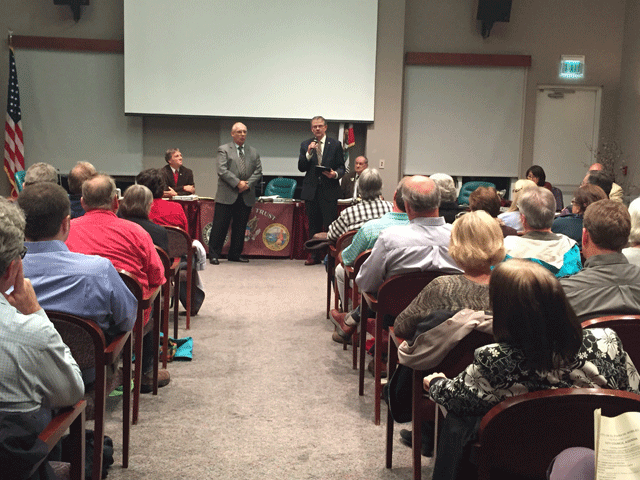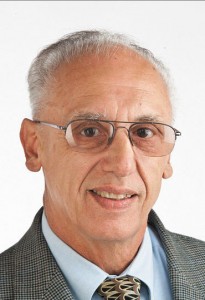Duane Picanco reflects on 32 years of service to Paso Robles

Outgoing mayor Duane Picanco, left, is recognized by incoming mayor Steve Martin for his 24 years on the Paso Robles City Council as councilman and mayor. Martin was sworn in later as mayor. Photo by Heather Young
After serving 24 years as a Paso Robles city council member and mayor, Duane Picanco is now enjoying a life of retirement. He served as elected mayor from 2008 through 2014. For the November 2014 election, Picanco decided to not run for mayor again, instead he pursued one of two seats up for grabs.
“I wanted a little more time for me and my family,” Picanco said of his decision to not run for mayor. “I just felt maybe it was time to step back, but I still felt interested and wanted to be involved [in city council].”

Duane Picanco
He came in the third highest vote-getter out of five contenders. Steve Martin was halfway through his four-year term as councilman when he ran unopposed for the mayoral seat, leaving his seat vacant after he was sworn-in as mayor in December. The council decided to appoint someone from the pool of unsuccessful candidates to that seat. Although Martin nominated Picanco, the other three members — John Hamon Jr., Jim Reed and Fred Strong — voted for Steve Gregory.
“After [the November] election I wasn’t planning on running again. [Now], I don’t know [if I’ll run in the next election]. I haven’t even thought that far. I won’t say never … but it’s not on my mind,” Picanco said.
Picanco and his family moved to Paso Robles more than 30 years ago; he worked in a business in downtown Paso Robles. Working in downtown spurred him to get involved in getting more parking in the downtown. Having lived in Tulare before moving to Paso Robles, he knew what could happen if parking wasn’t considered. He co-chaired the downtown parking district committee in the late 70s. After working with the city and the planning commission to get the parking lots approved, he became interested in the process at the planning commission level.
“I found it interesting,” Picanco said. “That’s what motivated me to apply for the planning commission.”
He was appointed by the council as a whole to the commission in 1982 and served on it until he was elected to the city council in 1990. He was appointed mayor 1996-2000. In 1999, the council discussed not appointing the mayor, but rather the mayor being an elected seat. The first mayor after the mayoral seat became elected, Picanco did not run for it. Rather he ran for city council and gave his blessing to Frank Mecham to run for mayor. Mecham served as mayor until 2008, when he was elected to the San Luis Obispo County Board of Supervisors. Until 2014, the mayoral seat was a two-year term. “That two-year time became quite challenging for mayor,” Picanco said, because as soon as one gets comfortable, it’s time to run for re-election. The council seats are all four-year terms.
“I have been very, very fortunate and appreciative [of the] confidence from the voters to elect me. It’s really been great,” Picanco said, noting that “there have been some challenges.”
He said that the biggest challenge faced by the council has been financial. Though he said that the council has accomplished many things over the 24 years he served on the council. The biggest accomplishment he said was building out the projects outlined in Measure D-98: bridges, Public Safety Center, Barney Schwartz Park, veterans and senior centers, airport industrial development improvements, and Cuesta College infrastructure improvements. Picanco said the final piece of that was the completion of the 13th Street Bridge improvements. D-98 was passed in 1998 just as, he said, the city was coming out of another recession, so the council directed that the projects get done as quickly as possible.
“To me, that was very, very significant,” Picanco said.
In addition to other boards that he served on, the one he served on the longest — LAFCO, Local Agency Formation Commission — is the most notable, especially since Paso Robles could lose its seat on that committee. The seven-member committee is made up of two representatives from county cities, two from the county, two from the community services district and one at-large. Each term is four years in length.
“I met an awful lot of people I wouldn’t have met otherwise,” Picanco said of his service to the city.






















